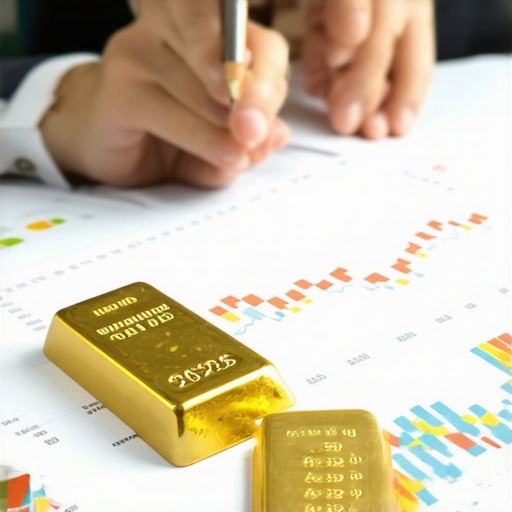Deciphering the Future of Gold: Emerging Demand Trends and Market Dynamics in 2025
As we approach the mid-2020s, understanding the evolving landscape of gold demand is crucial for investors, policymakers, and industry stakeholders. The intricate interplay of geopolitical shifts, technological advancements, and macroeconomic factors influences gold prices, demanding a nuanced analysis rooted in expert insights.
Global Economic Shifts and Their Role in Shaping Gold Demand
The global economy’s trajectory, marked by inflationary pressures and currency volatility, continues to elevate gold’s status as a safe-haven asset. Central banks, notably those in emerging markets, are increasing their gold reserves, which significantly impacts market prices. According to the recent white paper on central bank purchases, these institutional movements are pivotal in setting the tone for 2025’s market outlook.
Shifts in Jewelry and Industrial Demand: Surprising Catalysts
Demand from the jewelry sector remains a key driver, especially in regions like India and China. However, technological innovations—such as the integration of gold in electronics and renewable energy solutions—are creating new industrial demand streams. This diversification not only stabilizes prices but also introduces complex supply-demand dynamics that experts must monitor closely.
What Are the Long-Term Implications of These Emerging Demand Trends on Gold Prices in 2025?
Prolonged shifts in demand patterns, especially driven by technological and geopolitical factors, suggest a potential for increased price volatility. Investors should consider diversifying through instruments like gold ETFs and mutual funds to hedge against market fluctuations effectively.
Technological Innovations and Digital Asset Synergies
The rise of digital gold and blockchain-based assets presents both challenges and opportunities. These innovations are expanding access and liquidity, but also require investors to develop new expertise in digital asset management. Industry leaders suggest integrating physical gold with digital strategies for optimized portfolio resilience.
Expert Strategies for Navigating 2025’s Gold Market
Developing a robust gold investment portfolio involves understanding demand drivers, market timing, and risk mitigation. Experts advocate a balanced approach—combining physical assets with financial instruments—while staying informed via authoritative sources like the latest market forecasts.
How Will Geopolitical Tensions and Economic Policies Influence Gold Prices in 2025?
Geopolitical uncertainties tend to bolster gold’s safe-haven appeal, often causing price surges. Economic policies, especially those involving monetary easing or tightening, also significantly affect demand and supply balances. Staying abreast of these factors is essential for strategic investment decisions.
For a comprehensive understanding of how global economic factors will shape the gold market, consult detailed analyses like this expert report. Engage with industry professionals and contribute insights to refine forecasting models and investment strategies.
Understanding the Complex Interplay of Geopolitical Risks and Economic Policies on Gold
As we delve deeper into the factors influencing gold prices in 2025, it becomes evident that geopolitical tensions and shifting economic policies are paramount. These elements create a dynamic environment where gold acts not just as a store of value but also as a strategic hedge against uncertainty.
Geopolitical Tensions: Catalyst for Safe-Haven Flows
Conflicts, trade disputes, and regional instability often trigger surges in gold demand, as investors seek refuge from volatile markets. For instance, rising tensions in Eastern Europe or the Asia-Pacific region can lead to immediate price spikes. According to a comprehensive analysis in market forecasts for 2025, these geopolitical factors are expected to remain influential through the year.
Economic Policies: The Dual-edged Sword of Monetary and Fiscal Measures
Central banks’ policies, especially regarding interest rates and stimulus measures, directly impact gold’s attractiveness. Easing policies tend to weaken fiat currencies, making gold a more appealing alternative, while tightening measures can suppress demand. Notably, the trend of quantitative easing in major economies fuels inflation fears, which in turn increases gold’s safe-haven appeal.
Can Strategic Policy Adjustments Stabilize or Accelerate Gold Prices in 2025?
This question prompts investors and policymakers alike to consider how deliberate fiscal and monetary strategies might influence the trajectory of gold. For example, the possibility of coordinated international efforts to stabilize markets could temper volatility, whereas unilateral policy shifts might exacerbate it. For a nuanced understanding, see the detailed insights provided by experts analyzing global economic impacts.
If you’re keen to deepen your investment strategy, consider exploring how to leverage geopolitical developments by diversifying through tools like gold ETFs and mutual funds. Sharing your thoughts or questions in the comments can also help foster a community of well-informed investors.
The Impact of Digital Transformation on Gold Trading and Market Access
As blockchain technology and digital assets continue to revolutionize financial markets, gold trading is experiencing a paradigm shift. Digital gold platforms and tokenized assets are breaking down geographical barriers, enabling a new wave of investors to access physical gold through decentralized exchanges. This technological evolution not only enhances liquidity but also introduces complexities related to regulatory compliance and security protocols. Industry reports, such as those from the Crypto Briefing on Digital Gold, highlight how these innovations are shaping the future landscape of gold investments.
How Can Investors Leverage Digital Gold for Portfolio Diversification and Risk Management?
Integrating digital gold into traditional investment portfolios offers a strategic hedge against fiat currency depreciation and market volatility. Experts recommend combining physical gold holdings with tokenized assets to benefit from real-time liquidity and fractional ownership. This hybrid approach allows investors to respond swiftly to market shifts while maintaining long-term store-of-value assets. Furthermore, the transparency and traceability inherent in blockchain technology mitigate risks associated with counterfeit gold and fraud.
Supply Chain Resilience and Sustainability Challenges in Gold Mining
Securing a sustainable and ethically sourced gold supply chain is increasingly vital as demand escalates. Modern mining operations face environmental scrutiny, labor rights concerns, and geopolitical risks. Advances in automation and remote sensing technologies are improving traceability, ensuring compliance with ethical standards. According to a detailed analysis by the Sustainable Mining Journal, integrating these innovations can significantly reduce supply disruptions and bolster investor confidence.
What Are the Long-Term Implications of Supply Chain Innovations for Gold Price Stability?
Enhanced transparency and resilience in supply chains are likely to stabilize gold prices by reducing speculative volatility driven by supply uncertainties. As consumers and investors demand ethically sourced gold, companies that adopt these innovations may enjoy a competitive edge, potentially influencing market dynamics. Moreover, increased traceability could lead to higher premiums for responsibly mined gold, affecting overall market pricing strategies.
Emerging Geopolitical Hotspots and Their Influence on Gold Investment Strategies
Geopolitical tensions in regions like the Middle East, Eastern Europe, and the Indo-Pacific continue to be significant drivers of safe-haven demand. However, the complexity of these conflicts requires investors to adopt nuanced strategies that factor in not just immediate risk but also long-term geopolitical trends. Scenario analysis and geopolitical risk modeling, as discussed in the International Policy Review, can provide valuable insights for strategic asset allocation.
How Can Investors Prepare for Geopolitical Shifts That Impact Gold Prices?
Proactive diversification across geographies and asset classes, combined with real-time geopolitical intelligence, can mitigate adverse effects. Utilizing derivatives and options to hedge against sudden price spikes or drops also enhances risk management. Engaging with geopolitical risk consultancy firms for tailored insights can further refine investment strategies in this volatile environment.
For those eager to deepen their understanding, exploring interdisciplinary approaches that combine geopolitical analysis with macroeconomic forecasting will be crucial. Engaging with expert communities and staying updated on international developments will empower investors to make informed decisions amidst increasing global uncertainty.
Harnessing the Power of Quantum Computing for Gold Market Forecasting
Emerging technologies such as quantum computing promise to revolutionize market analysis by enabling the processing of vast datasets and complex predictive models with unprecedented speed. This leap forward could allow investors and analysts to forecast gold price movements with higher accuracy, considering multifaceted geopolitical, macroeconomic, and technological variables simultaneously. According to a 2024 report from Quantum Tech Journal, integrating quantum algorithms into financial modeling is no longer theoretical but a practical tool poised to reshape strategic decision-making in commodities trading.
Adaptive Risk Management: Implementing AI-Driven Portfolio Optimization
Artificial Intelligence (AI) and machine learning are increasingly instrumental in crafting dynamic investment portfolios that adapt to volatile market conditions. By analyzing real-time data streams—ranging from geopolitical developments to macroeconomic indicators—these systems can recommend optimal asset allocations, including gold, to mitigate risks and capitalize on emerging opportunities. Leading financial institutions are now deploying AI-powered tools for continuous portfolio rebalancing, thus maintaining resilience amidst unpredictable fluctuations, as detailed in the latest issue of FinTech Insights.
What Expert Techniques Are Used to Integrate AI and Quantum Computing for Gold Investment Strategies?
Combining AI with quantum computing involves layered algorithms that process market signals at quantum speeds, enabling high-frequency trading and predictive analytics with heightened precision. Experts suggest hybrid models that leverage classical AI for pattern recognition and quantum processors for optimization problems, thereby crafting a sophisticated, multi-dimensional view of market dynamics. To explore these cutting-edge methodologies, consult publications like Advanced FinTech.
Environmental Sustainability and Ethical Sourcing: New Paradigms in Gold Supply Chain Management
As demand for ethically mined gold surges, innovations in blockchain technology and remote sensing are transforming supply chain transparency. Companies adopting these advancements can verify compliance with environmental standards and labor rights, fostering consumer trust and commanding premium prices. The integration of AI-powered traceability solutions further enhances supply resilience and reduces fraud, as highlighted in the Sustainable Mining Technology Review.
How Will Blockchain and Remote Sensing Technologies Reshape Gold Supply Chain Integrity?
These technologies enable end-to-end traceability, ensuring that each gold bar can be authenticated and ethically sourced. Implementing such systems not only mitigates supply disruptions but also aligns with global ESG (Environmental, Social, and Governance) standards, potentially leading to higher market premiums for responsibly sourced gold. Industry leaders recommend adopting integrated digital platforms for comprehensive supply chain management, providing transparency and reinforcing market confidence.
Strategic Geopolitical Foresight: Preparing for Volatility in Key Regions
Investors increasingly rely on geopolitical risk modeling to anticipate and navigate conflicts and policy shifts that influence gold prices. Advanced scenario planning, supported by AI-driven geopolitical intelligence platforms, enables the development of resilient investment strategies that accommodate regional uncertainties in the Middle East, Indo-Pacific, and Eastern Europe. As detailed in the Global Geopolitical Risk Assessment, these tools provide vital foresight for strategic asset allocation in a complex world.
How Can Investors Leverage Geopolitical Analysis to Optimize Gold Portfolio Performance?
Proactive diversification across geographies and asset classes, combined with real-time intelligence, empowers investors to hedge against regional instabilities and capitalize on safe-haven flows. Incorporating derivatives such as options and futures further enhances flexibility, allowing rapid response to geopolitical shocks. Engaging with specialized risk consultancy services can refine these strategies, ensuring resilience amid escalating international tensions.
Expert Insights & Advanced Considerations
1. Market Diversification with Digital Assets
Integrating physical gold with blockchain-based tokens enhances liquidity and provides a hedge against fiat currency depreciation, aligning with evolving digital finance trends.
2. Supply Chain Transparency as a Market Stabilizer
Adopting blockchain and remote sensing technologies ensures ethically sourced gold, reducing supply disruptions and supporting price stability in a volatile geopolitical environment.
3. Geopolitical Risk Modeling for Strategic Asset Allocation
Utilizing AI-driven scenario analysis enables investors to anticipate regional conflicts and policy shifts, optimizing portfolio resilience in uncertain global conditions.
4. Leveraging Quantum Computing & AI for Market Forecasting
Emerging quantum algorithms combined with AI facilitate high-precision predictions of gold prices, incorporating multifaceted geopolitical and macroeconomic data.
5. Sustainability as a Competitive Edge
Companies implementing ESG-compliant practices in gold sourcing can command premium prices, influencing market dynamics and encouraging responsible investment behaviors.
Curated Expert Resources
- Global Central Bank Gold Purchases: Provides insights into institutional demand shifts; essential for understanding macroeconomic influences on gold prices.
- Market Analysis 2025 – Critical Demand Drivers: An authoritative forecast highlighting demand patterns and price trajectories based on current trends.
- Crypto Briefing on Digital Gold: Explores innovations in blockchain and tokenization, vital for modern portfolio diversification strategies.
- Sustainable Mining Journal: Offers expert analysis on supply chain innovations and ethical sourcing, crucial for long-term market stability.
- Quantum Tech Journal: Details advancements in quantum computing applications for financial modeling, promising to revolutionize market predictions.
Final Expert Perspective
As the gold market approaches 2025, embracing technological innovations such as blockchain, quantum computing, and AI-driven risk analysis is paramount for maintaining competitive advantage. Strategic diversification, ethical sourcing, and geopolitical foresight will shape resilient portfolios amid global uncertainties. Engaging with authoritative resources and staying ahead of emerging trends ensures informed decision-making. We invite you to deepen your expertise and contribute insights—your strategic perspective can influence the future trajectory of gold investments. For ongoing updates and expert discussions, explore our comprehensive market forecasts and join the community of informed investors.










